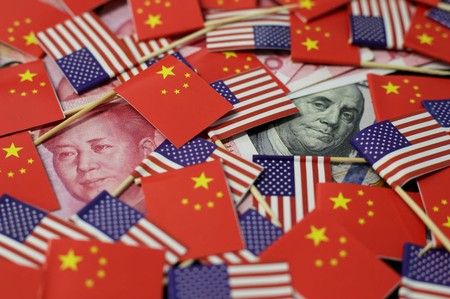
Global stocks fell for a sixth day on Monday as an escalation of trade tensions between the United States and China spooked markets and the yuan fell to its lowest levels in over a decade.
Safe-haven assets including the Japanese yen, core government bonds and gold rallied.
European shares fell to two-month lows, with the pan-European STOXX 600 index <.STOXX> shedding 2% on top of the 2.5% it lost on Friday – its worst day so far in 2019 – after U.S. President Donald Trump signaled another round of tariffs on Chinese imports.
“Markets had not been expecting the latest US-China trade talks to conclude with any significant breakthrough last week, but very few expected President Trump to slap 10% tariffs on $300 billion worth of Chinese goods,” said Hussein Sayed, chief market strategist at FXTM.
MSCI’s All Country World Index, which tracks shares in 47 countries, was down 0.7% on the day. That put it down almost 2% including Friday’s loss.
Asian shares suffered their steepest daily drop in 10 months, with MSCI’s broadest index of Asia-Pacific shares outside Japan sinking 2.5% to depths not seen since late January.
The VIX <.VIX> volatility index – also known as Wall Street’s “fear gauge” – rose to 19.02%, its highest since May 13, while Europe’s equivalent <.V2TX> hit its highest since early January.
S&P 500 futures were 1.35% lower.
“We reiterate our view to scale back equity positions to strategic allocations after strong gains year to date, amid the ongoing trade-related uncertainties,” Credit Suisse analysts wrote in a note to clients.
The biggest mover in currencies was the yuan, which fell past the key level of 7 to the dollar as Chinese authorities – expected to defend the currency at that level – allowed it to break through to its lowest in the onshore market since the 2008 global financial crisis.
In offshore markets, the yuan fell to its weakest since international trading of the Chinese currency began. Headed for its biggest one-day drop in four years, it was last down 1.4% at 7.0744 in offshore markets.
“Over the past couple of years, China has kept the renminbi stable against the basket, but with the renminbi TWI (trade-weighted index) now testing the lower end of the range in play since 2017, investors may turn nervous, introducing another dose of volatility,” Morgan Stanley strategists wrote in a note to clients.
The currencies of other Asian economies closely linked with China’s growth prospects also dropped.
The Korean won fell 1.4% against the dollar, on course for its biggest one-day loss since August 2016. The new Taiwan dollar fell more than 0.7% .
BID FOR SAFETY
Japan’s yen, which investors tend to buy in times of risk aversion, rose 0.7% to its highest since a January flash crash.
Dutch 30-year government bond yields turned negative for the first time as euro zone yields sank further amid concerns about U.S.-China trade and a no-deal Brexit.
U.S. 10-year yields dived 7 basis points to 1.77%, while Germany’s 10-year bund yields fell to -0.53%. The three-month to 10-year U.S. yield curve was at its most inverted in 11 years.
The Swiss franc was also boosted by safe-haven demand. Trump is also eyeing tariffs on the European Union, but has yet to make a formal announcement. The euro was 0.3% higher to the dollar at $1.1137.
Sterling hovered near 2017 lows at $1.2117, pressured by concerns about Britain exiting the EU without a trade deal in place.
Oil extended losses with U.S crude down 1.55% at $54.8 and Brent down 1.55% at $60.92.
Gold prices jumped more than 1% to their highest in more than six years, with spot gold prices up 1.1% to $1,456.51 per ounce.